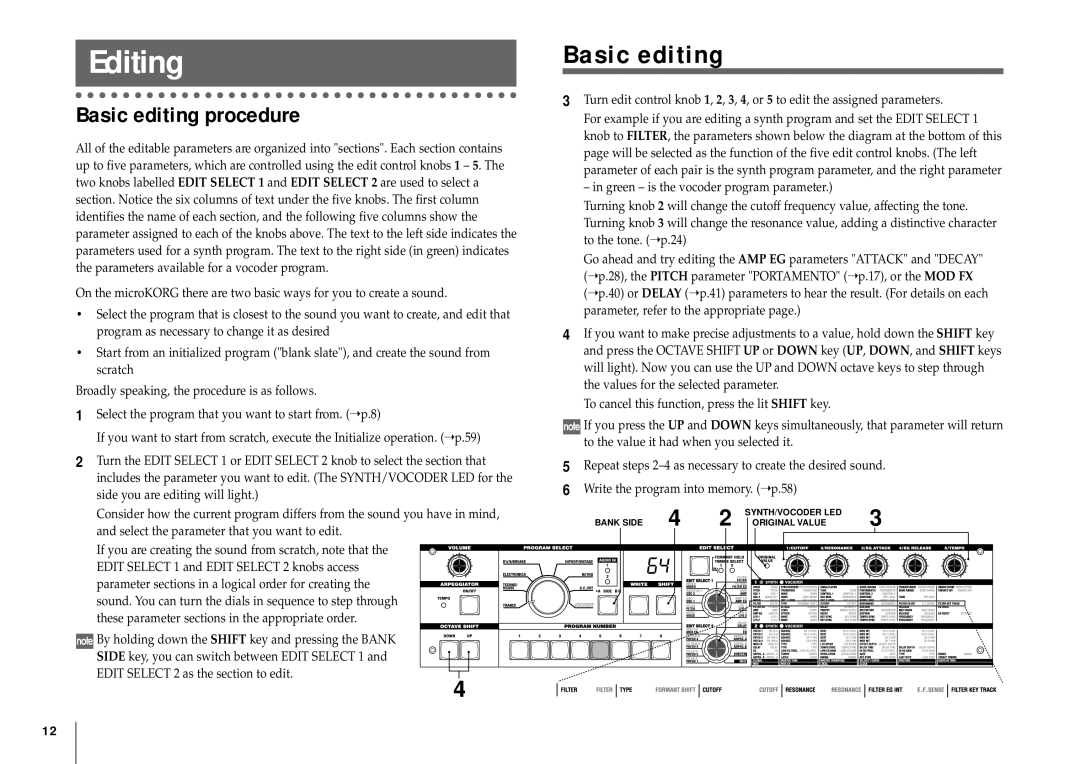
Editing
Basic editing
Basic editing procedure | 3 | Turn edit control knob 1, 2, 3, 4, or 5 to edit the assigned parameters. | |||||
| For example if you are editing a synth program and set the EDIT SELECT 1 | ||||||
All of the editable parameters are organized into "sections". Each section contains |
| knob to FILTER, the parameters shown below the diagram at the bottom of this | |||||
| page will be selected as the function of the five edit control knobs. (The left | ||||||
up to five parameters, which are controlled using the edit control knobs 1 – 5. The |
| ||||||
| parameter of each pair is the synth program parameter, and the right parameter | ||||||
two knobs labelled EDIT SELECT 1 and EDIT SELECT 2 are used to select a |
| ||||||
| – in green – is the vocoder program parameter.) |
| |||||
section. Notice the six columns of text under the five knobs. The first column |
|
| |||||
| Turning knob 2 will change the cutoff frequency value, affecting the tone. | ||||||
identifies the name of each section, and the following five columns show the |
| ||||||
| Turning knob 3 will change the resonance value, adding a distinctive character | ||||||
parameter assigned to each of the knobs above. The text to the left side indicates the |
| ||||||
| to the tone. (➝ p.24) |
|
|
| |||
parameters used for a synth program. The text to the right side (in green) indicates |
|
|
|
| |||
| Go ahead and try editing the AMP EG parameters "ATTACK" and "DECAY" | ||||||
the parameters available for a vocoder program. |
| ||||||
| (➝ p.28), the PITCH parameter "PORTAMENTO" (➝ p.17), or the MOD FX | ||||||
|
|
| |||||
On the microKORG there are two basic ways for you to create a sound. |
| (➝ p.40) or DELAY (➝ p.41) parameters to hear the result. (For details on each | |||||
• Select the program that is closest to the sound you want to create, and edit that |
| parameter, refer to the appropriate page.) |
| ||||
| program as necessary to change it as desired | 4 | If you want to make precise adjustments to a value, hold down the SHIFT key | ||||
• Start from an initialized program ("blank slate"), and create the sound from |
| and press the OCTAVE SHIFT UP or DOWN key (UP, DOWN, and SHIFT keys | |||||
| scratch |
| will light). Now you can use the UP and DOWN octave keys to step through | ||||
Broadly speaking, the procedure is as follows. |
| the values for the selected parameter. |
| ||||
| To cancel this function, press the lit SHIFT key. |
| |||||
1 | Select the program that you want to start from. (➝ p.8) |
|
| ||||
| If you press the UP and DOWN keys simultaneously, that parameter will return | ||||||
| If you want to start from scratch, execute the Initialize operation. (➝ p.59) |
| |||||
|
| to the value it had when you selected it. |
| ||||
|
|
|
| ||||
2 | Turn the EDIT SELECT 1 or EDIT SELECT 2 knob to select the section that | 5 | Repeat steps | ||||
| includes the parameter you want to edit. (The SYNTH/VOCODER LED for the | ||||||
| 6 | Write the program into memory. (➝ p.58) |
| ||||
| side you are editing will light.) |
| |||||
|
|
|
|
|
|
| |
| Consider how the current program differs from the sound you have in mind, |
| BANK SIDE | 4 | 2 | SYNTH/VOCODER LED | 3 |
| and select the parameter that you want to edit. |
| ORIGINAL VALUE | ||||
|
|
|
|
|
|
| |
| If you are creating the sound from scratch, note that the |
|
|
|
|
|
|
| EDIT SELECT 1 and EDIT SELECT 2 knobs access |
|
|
|
|
|
|
| parameter sections in a logical order for creating the |
|
|
|
|
|
|
| sound. You can turn the dials in sequence to step through |
|
|
|
|
|
|
| these parameter sections in the appropriate order. |
|
|
|
|
|
|
| By holding down the SHIFT key and pressing the BANK |
|
|
|
|
|
|
| SIDE key, you can switch between EDIT SELECT 1 and |
|
|
|
|
|
|
| EDIT SELECT 2 as the section to edit. |
|
|
|
|
|
|
4
12
